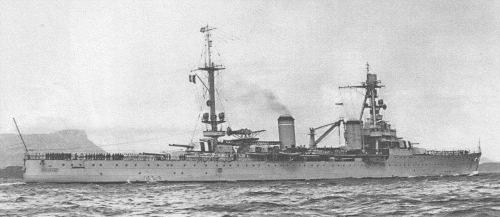
NAVYPEDIA
 Support the project with paypal
Support the project with paypal
Photo

Duquesne 1937
Ships
| Name | No | Yard No | Builder | Laid down | Launched | Comp | Fate |
|---|---|---|---|---|---|---|---|
| Duquesne | Arsenal de Brest | 30.10.1924 | 17.12.1925 | 6.12.1927 | FNFL 6.1943, depot ship late 1948 | ||
| Tourville | Arsenal de Lorient | 4.3.1925 | 24.8.1926 | 1.12.1928 | FNFL 6.1943, accommodation ship late 1948 |
Technical data
| Displacement standard, t | 10000 |
|---|---|
| Displacement full, t | 12200 |
| Length, m | 185.0 pp 191.0 oa |
| Breadth, m | 19.0 |
| Draught, m | 6.32 full load |
| No of shafts | 4 |
| Machinery | 4 sets Rateau-Bretagne geared steam turbines, 9 Guyot du Temple boilers |
| Power, h. p. | 120000 |
| Max speed, kts | 33.7 |
| Fuel, t | oil 1820 |
| Endurance, nm(kts) | 5500(13) |
| Armour, mm | deck: 24 - 22, turrets: 30, CT: 30, citadel (magazines and steering gear): 30 |
| Armament | Duquesne: 4 x 2 - 203/50 M1924, 8 x 1 - 75/50 M1924, 8 x 1 - 37/50 M1925, 2 x 3 - 550 TT, 1 catapult, 1 seaplane (F.B.A.17) Tourville: 4 x 2 - 203/50 M1924, 8 x 1 - 75/50 M1924, 8 x 1 - 37/50 M1925, 2 x 3 - 550 TT, 1 catapult, 1 seaplane (F.B.A.17, CAMS.37) |
| Complement | 605 |
Standard scale images

Duquesne 1939

Tourville 1945
Graphics
Project history
Built under the 1924 programme. First French "Washington" cruisers. In certain degree they presented the increased variant of Duguay Trouin class with improved hull form. Intended for long-distance reconnaissance and operations on trade communications, first of all colonial. According to the task cruisers should exceed on speed all possible opponents (British and US light cruisers), and their armament should ensure the superiority over light and auxiliary merchant cruisers. Proceeding from tasks weakness of their armour protection (weight of armour was only 430t) was not a significant lack. Practically they had no underwater protection, only thickened longitudinal bulkheads abreast machinery.
Both ships during trials reached designed speed. Duquesne on 4hour trials developed overall speed 34.12kts at 131770hp (maximum speed was 35.3kts), and Tourville during 6hour trials signed 33.22kts overall at 126900hp (maximum speed was 34.13kts). As a whole these ships were characterised as well seaworthy and handy ships: 30kts speed they easily made at half power of main machinery.
In 1930s variants of conversion to light aircraft carriers were studied. It was supposed, that in new quality they can carry 12-14 aircrafts. Three variants of project from four provided preservation of fwd or aft turret pairs. Detailed study of projects have refused in favour of project of real aircraft carrier of Joffre class.
Ship protection
Magazines and steering gear had box-shaped 30-mm protection. Outer transverse bulkheads of engine spaces had 20-mm thickness. Machinery was additionally protected by 14 - 12-mm torpedo bulkhead.
Modernizations
1936, both: + 4 x 2 - 13.2/76
late 1930s, both: + 2 x 2 - 13.2/76
11/1945, Duquesne: - 8 x 1 - 37/50, 6 x 2 - 13.2/76, 2 x 3 - 550 TT, catapult with seaplane; + 8 x 1 - 40/56 Mk 1.2, 20 x 1 - 20/70 Mk 4, SA-2, SF-1 radars
11/1945, Tourville: - 8 x 1 - 37/50, 6 x 2 - 13.2/76, 2 x 3 - 550 TT, catapult with seaplane; + 8 x 1 - 40/56 Mk 1.2, 16 x 1 - 20/70 Mk 4, SA-2, SF-1 radars
Naval service
In July, 1940 as a part of Force "X" both cruisers were disarmed at Alexandria, but remained under the French control. In May, 1943 they came over to the side of Gaullist Algerian Government and joined FNFL 24.6.1943.
Tourville in 1944-1945 was used as personnel transport. Both ships joined FNFL 24.6.1943. Duquesne was used as amphibious forces depot ship from late 1948 and stricken 2.7.1955, Tourville served as accommodation vessel from late 1948 and was stricken 8.3.1962.
 HOME
HOME FIGHTING SHIPS OF THE WORLD
FIGHTING SHIPS OF THE WORLD FRANCE
FRANCE CRUISERS
CRUISERS DUQUESNE heavy cruisers (1928)
DUQUESNE heavy cruisers (1928)

